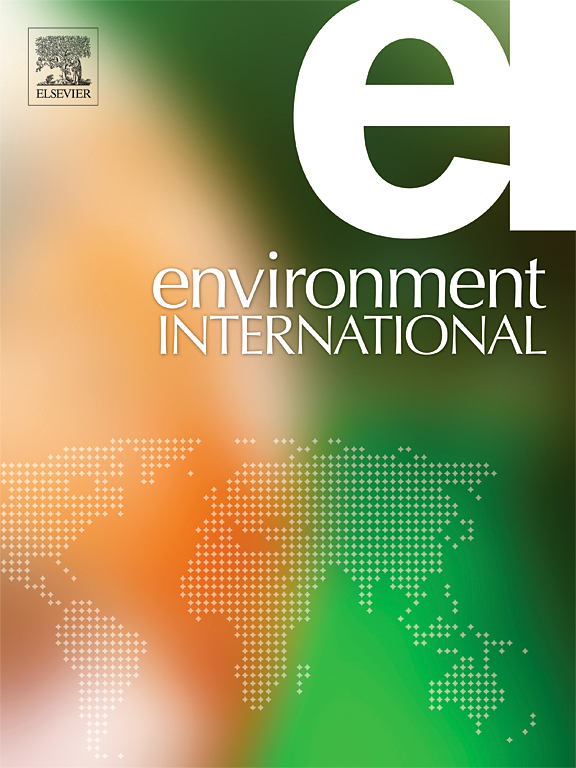环境空气颗粒物和臭氧暴露对低出生体重的协同风险:一项为期11年的中国产妇纵向队列研究
IF 9.7
1区 环境科学与生态学
Q1 ENVIRONMENTAL SCIENCES
引用次数: 0
摘要
观察性流行病学研究表明,孕产妇暴露于空气污染会增加不良妊娠结局的风险。然而,多种环境暴露之间的相互作用仍未得到充分探讨。在这项研究中,我们对2013年至2023年间从中国东南部9个省份招募的147979名孕妇进行了流行病学分析,重点关注低出生体重(LBW)的风险。我们发现PM2.5和臭氧(O3)的关键暴露窗口从孕前6个月一直延伸到妊娠中期结束,每增加10-μg/m3 PM2.5暴露的风险比 = 1.152(95 %置信区间[CI]: 1.128-1.177),每增加10-ppb O3的风险比 = 1.028(95 % CI: 1.024-1.031)。我们的估计表明,到2021年,中国全国约有47,500(95 %不确定区间[UI]: 41,200-53,600)例活产低体重婴儿可归因于环境空气污染,而2002年为79,800(95 % UI: 71,700-87,900)。我们观察到统计学上显著的协同风险效应,忽略这一点可能导致11,600例(95 % UI: 9,300-13,900) LBW病例被低估。尽管与空气污染相关的轻生负担正在减少,但轻生发病率的迅速上升仍然是一个重大的公共卫生问题,特别是在中国实施“三孩政策”的情况下。因此,我们的研究为保障生殖健康提供了精确量化的、基于证据的政策指导。本文章由计算机程序翻译,如有差异,请以英文原文为准。
Synergistic risks of ambient air particulate matter and ozone exposure on low birth weight: An 11-year longitudinal Chinese maternity cohort study
Observational epidemiological studies have demonstrated that maternal exposure to air pollution increases the risk of adverse pregnancy outcomes. However, interactions among multiple environmental exposures remain underexplored. In this study, we performed an epidemiological analysis on 147,979 pregnant women recruited from nine provinces in southeastern China between 2013 and 2023, focusing on the risk of low birth weight (LBW). We found that the critical exposure windows for PM2.5 and ozone (O3) extend from six months prior to conception through the end of second trimester, with hazard ratio of HR = 1.152 (95 % confidence interval [CI]: 1.128–1.177) per 10-μg/m3 incremental PM2.5 exposure and HR = 1.028 (95 % CI: 1.024–1.031) per 10-ppb increase in O3. Our estimates indicate that in 2021, approximately 47,500 (95 % uncertainty interval [UI]: 41,200–53,600) live-born LBW infants nationwide in China could be attributed to ambient air pollution, declining from 79,800 (95 % UI: 71,700–87,900) in 2002. We observed statistically significant synergistic risk effects, neglecting which could lead to an underestimation of 11,600 (95 % UI: 9,300–13,900) LBW cases. Although air pollution-associated LBW burden is decreasing, the rapidly rising LBW prevalence remains a significant public health concern, particularly as China is implementing the “three-child policy”. Therefore, our study offers precisely quantified, evidence-based policy guidance for safeguarding reproductive health.
求助全文
通过发布文献求助,成功后即可免费获取论文全文。
去求助
来源期刊

Environment International
环境科学-环境科学
CiteScore
21.90
自引率
3.40%
发文量
734
审稿时长
2.8 months
期刊介绍:
Environmental Health publishes manuscripts focusing on critical aspects of environmental and occupational medicine, including studies in toxicology and epidemiology, to illuminate the human health implications of exposure to environmental hazards. The journal adopts an open-access model and practices open peer review.
It caters to scientists and practitioners across all environmental science domains, directly or indirectly impacting human health and well-being. With a commitment to enhancing the prevention of environmentally-related health risks, Environmental Health serves as a public health journal for the community and scientists engaged in matters of public health significance concerning the environment.
 求助内容:
求助内容: 应助结果提醒方式:
应助结果提醒方式:


